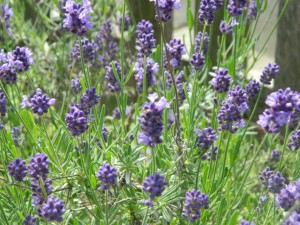Grow Lavender
Lavendula angustifolia is a great perennial herb known for its deep blue/lavender flowers and silvery/gray foliage. Given the right conditions lavender is an easy, drought resistant, low maintenance plant to grow.
A native to the Mediterranean, it tolerates heat and drought and usually blooms in July-September. The English (Vicenza Blue) Hidcote, Mumstead varieties are USDA hardy in zones 5-9, Heat zone 2-7. They can be grown as perennials in these zones but in colder regions should be treated as an annual.
Care
Three things to remember when growing lavender.
Sweet soil, excellent drainage and winter protection against heaving.
How to grow it
Plant in well-drained to dry soil in full to part sun. Lavender prefers alkaline soil with a ph of 7.0 or more. Maintain the plant on the dry side-too much water will kill the roots, especially in winter. Pick the flower spikes to encourage more blooms during the growing season.
Prune
In mid-Spring cut back 1/3 of your lavender plant and trim out any winter-damaged stems. After a few years of growth the shrubby herb will look bare at the base. Cut the plant back down to 8 inches to maintain a tidier plant and encourage new growth.
Harvesting and drying
Pick in mid-day when flowers are dry and when the top half of flowers are opened. Hang small bunches in a dark, dry area.
Uses
This plant has more qualities than meets the eye. Lavender has many uses;
- Known for its natural relaxing properties in calming nerves and insomnia,
- It also helps relieve dizziness, headaches, muscle pain, nausea, swelling, soreness, inflammation and has anti-fungal properties. Use on insect bites and burns.
- Lavender is also used to flavor jams, vinegar, oils and teas. Flowers are edible and crystalized for decoration.
- The fragrant flowers can be dried with a scent that will remain for years. Use in potpourri or place the dried flowers in sachets . The dried aromatic flowers deter pests, moths and ants in the garden as well as indoors.
Outdoor Use
Use lavender in border gardens, as low growing accent plants and in containers. It also attracts bees and butterflies and is deer resistant.
Cultivars
English lavender is highly prized for its fragrance.
French lavender (L. dentata) has finely toothed gray/green foliage and pale purple flowers.
Spanish Lavender (L. stoechas) narrow silvery foliage has plump dark purple flowers with elongated petals.
New! Lavender “Phenominal” is highly fragrant, drought tolerant and thrives in full sun.
Lavender “Platinum Blonde” has variegated leaves with silvery foliage. Compact growth that makes it great for containers.
I recently purchased a Platinum Blonde lavender plant. I have transplanted it into a larger container and it is out on the deck. But, it’s leaves are turning very dry at the ends and discolored. What is wrong and how can I fix it?
Hi.
I have a question about my lavender plant. (Outdoors). It is really huge. Do I cut this down at the end of the summer? Also,I would like to pick some of it to make my house smell pretty. Will this hurt the ;plant? I want to have it bloom every year that is why I hesitate to trim it down.
Thanks Diana
Planted a lavender plant this summer –
I live in Louisville Ky. area – what do I do to protect the plant during the winter?
thank you in advance for your reply – mg hailey
I have recently, a month ago planted a flower border of lavender plants, Munsted and Hidcote. I made every attempt to give adequate but not to much water. The plants started well but now they are turning black from the base upward. I can find no information on what this may be. We have had fine weather since they were planted. Please help me save my plants!
How can I take care of my lavender (not sure what species) over the winter. It’s planted in a container on the deck? I live in zone 7.